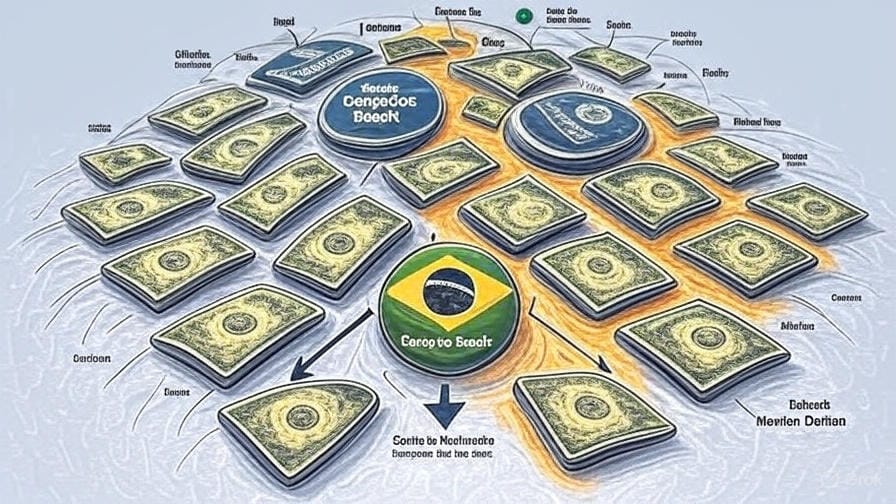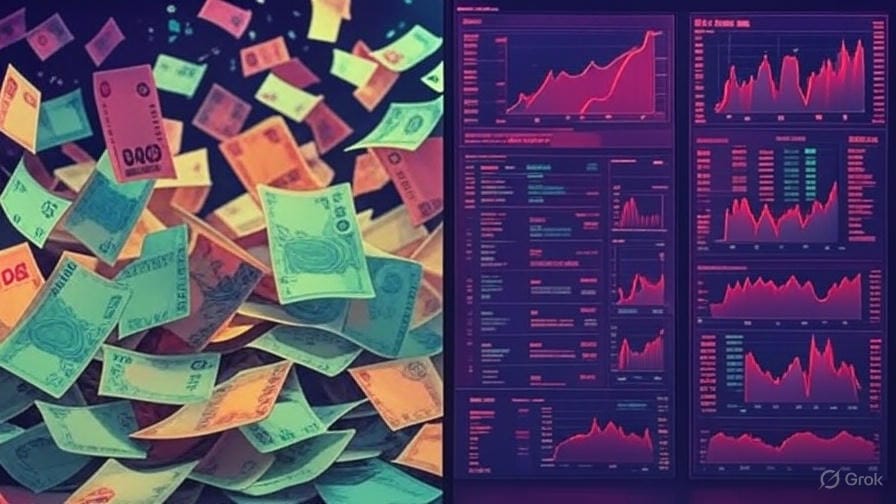The Druid Deep Dive episode 8: Brazilian hyperinflation: The ultimate portfolio stress test (1980-1994)
Brazil's hyperinflation (1980-1994) stemmed from decentralized money creation - state banks could print currency. Terra LUNA's collapse shows how DeFi protocols can trigger similar spirals when multiple mechanism can trigger token creation simultaneously.

Ancient wisdom for modern DeFi - Season 2, Episode 8
When banks became money printers and chaos became profitable
Brazil’s hyperinflation crisis from 1980-1994 created a unique institutional environment where state banks systematically profited from monetary chaos through sophisticated quasi-fiscal operations and float mechanisms. Annual inflation reached peaks of 2,947.7% in 1990, with monthly inflation hitting 81.3% in March 1990 [1]. The crisis stemmed from a decentralized monetary system that enabled multiple entities beyond the Central Bank to create money, undermining stabilization efforts through six failed economic plans before the successful Real Plan in 1994.
For modern DeFi participants constructing robust portfolio strategies, Brazil’s hyperinflation offers crucial lessons about how decentralized money creation can spiral beyond control - and how sophisticated actors position themselves to profit from monetary chaos while others lose everything.
Statistical verification confirms hyperinflation severity
The scale of Brazilian inflation during 1980-1994 exceeded most international comparisons. Annual inflation rates consistently exceeded 100% throughout most of the period, with dramatic acceleration after 1987 [2]. Specific yearly data reveals the progression: 138% (1983), 192% (1984), 226% (1985), escalating to 629% (1988), then exploding to 1,430% (1989) and reaching a devastating peak of 2,947.7% in 1990 [2]. The hyperinflation period proper began in 1989, characterized by monthly inflation exceeding 20-30% consistently.
Monthly inflation reached 81.3% in March 1990, confirming the approximate “80%” figure often cited [3]. However, the claim that monthly inflation was “around 80% in 1994 before the Real Plan” requires clarification: June 1994 saw 48% monthly inflation immediately before the Real Plan implementation, while the 80%+ figures occurred during the 1990 hyperinflation peak [3].
Brazil indeed held the world’s largest external debt by the second oil shock, reaching approximately $92 billion by decade’s end and $54 billion by 1980 [4]. This external debt burden created fiscal pressures that directly contributed to domestic monetary expansion and hyperinflationary dynamics.
The root cause: Fiscal irresponsibility amplified by decentralized money creation
How poor fiscal policy became hyperinflation through institutional design
Brazil’s hyperinflation was fundamentally a story of fiscal irresponsibility amplified by a decentralized monetary system that turned manageable deficits into catastrophic money printing. What began as standard government overspending became hyperinflation because Brazil’s unique institutional framework allowed multiple entities beyond the Central Bank to trigger money creation, each responding to fiscal pressures without coordination or restraint.
The central government’s fiscal deficit was the original sin, but the decentralized quasi-fiscal operations were the mechanism that transformed deficit spending into monetary chaos. Unlike traditional monetary systems where only the central bank controls money creation, Brazil operated a system where state governments, state banks, and federal agencies could effectively trigger printing money to finance their operations.

Quasi-fiscal operations: The multiplication mechanism
Brazil’s unique institutional framework allowed multiple entities beyond the Central Bank to create money through quasi-fiscal operations [7]. The most significant mechanism was the Conta de Movimento system (1965-1988) - a special account between the Central Bank and Banco do Brasil that enabled automatic money creation. Banco do Brasil could withdraw unlimited funds, automatically matched by monetary base expansion, effectively providing control over money issuance for government policies [7].
This system essentially gave the federal government unlimited access to the printing press without going through normal central bank constraints. When the government needed to finance agricultural subsidies, development programs, or emergency spending, Banco do Brasil would simply draw on the Conta de Movimento, automatically expanding the monetary base. The Central Bank had no effective veto power over these operations.
Nine of twenty-three states created their own banks between 1960-1964 to finance fiscal deficits [8]. State banks could operate with negative reserves, ultimately pressuring the Central Bank to expand the monetary base. The system became so decentralized that state governors discovered they could overdraw cash from Banco do Brasil accounts, with detection taking over a month due to lack of real-time information systems [8].
The multiplication effect was devastating: Each level of government - federal, state, and municipal - could trigger money creation through their respective banking relationships. A federal agricultural program, a state infrastructure project, and municipal payroll financing could all simultaneously expand the money supply without any entity understanding the aggregate impact.
The feedback loop: Inflation justified more money printing
The decentralized system created a vicious feedback loop where each entity justified their money creation as necessary to keep up with inflation caused by others’ money creation. State governors argued they needed to print money to maintain public services in an inflationary environment. Federal agencies claimed their programs required constant monetary expansion to remain effective. The Central Bank found itself accommodating rather than controlling these pressures.
Brazil effectively had multiple monetary authorities during the high-inflation period - state banks, Banco do Brasil, and Central Bank all capable of money creation [17]. This “provinces effect” occurred when different government entities chose deficit levels without considering aggregate impact, undermining central monetary control [17].
This decentralized money creation resembles algorithmic stablecoin protocols where multiple governance tokens can trigger minting mechanisms, potentially undermining the stability of the entire system when coordination breaks down - but with the added complexity that Brazil’s system involved actual government fiscal policy rather than just protocol governance.
Modern algorithmic stablecoin parallels: Terra LUNA and MakerDAO stress tests
The closest modern parallel to Brazil’s quasi-fiscal money creation occurs in algorithmic stablecoin protocols during stress scenarios. Terra’s UST collapse in May 2022 provides the most direct comparison to Brazil’s hyperinflationary feedback loops.
Terra’s Brazil-like mechanism: When UST lost its $1 peg, holders could redeem 1 UST for $1 worth of LUNA tokens. This required minting massive amounts of LUNA, creating a death spiral: UST depeg → LUNA minting → LUNA price collapse → more UST redemptions → more LUNA minting. Over 6 trillion LUNA tokens were minted in days, destroying both UST’s peg and LUNA’s value [19] - exactly the type of uncontrolled money creation that devastated Brazil.
MakerDAO’s March 2020 stress test revealed similar vulnerabilities on a smaller scale. When ETH collateral crashed from $150 to $90, DAI briefly depegged as underwater positions triggered liquidations. Multiple governance mechanisms activated simultaneously: emergency debt auctions, collateral auctions, and MKR token minting to cover bad debt. While MakerDAO survived, the episode demonstrated how multiple stabilization mechanisms can create competing pressures during crisis [20], requiring careful coordination to avoid the Brazil scenario.

The key parallel: Both Brazil and algorithmic stablecoins suffer from multiple entities or mechanisms capable of money creation without central coordination. Brazil had state banks, federal agencies, and Banco do Brasil all able to expand money supply. Terra had redemption mechanisms that triggered LUNA minting. MakerDAO has various governance committees and automated systems that can authorize token creation during emergencies.
State banks exploited hyperinflation through sophisticated mechanisms
The “float” revenue system generated massive private banking profits
Private commercial banks developed a sophisticated system to profit from hyperinflation through the “float” mechanism - capturing spreads between non-indexed deposits and inflation-protected government securities [5]. During hyperinflation periods, float revenues represented more than 35% of total bank revenues between 1990-1994, dropping to only 0.6% after the Real Plan’s success [6]. Private banks became “overly dependent on float revenues” as their primary profit source, making “substantial profits in just one night” by immediately investing demand deposits into indexed government securities [5].
This mechanism mirrors modern DeFi yield farming strategies where protocols capture value from the time lag between user deposits and optimal yield deployment. The Brazilian private banking system essentially operated as primitive automated market makers, profiting from the spread between what they paid depositors and what they earned on government securities.
The key insight: While state banks created the inflation through quasi-fiscal operations, private banks perfected the art of extracting profits from the resulting monetary chaos. This division of labor - state banks as money creators, private banks as profit extractors - explains why both required rescue when the inflationary environment ended.
How decentralized money creation enabled systematic profit extraction
The quasi-fiscal system didn’t just create hyperinflation - it created massive profit opportunities for private banks who understood the mechanics. While state banks were the tools creating inflation through quasi-fiscal operations, private commercial banks positioned themselves to systematically extract profits from the resulting monetary chaos.
Private banks could essentially arbitrage the government’s fiscal irresponsibility, knowing that state bank money creation would eventually translate into monetary expansion and inflation-protected returns on government securities. The state banks were the money creators, but the private banks were the sophisticated profit extractors.
This separation explains why both types of banks required rescue after the Real Plan: state banks lost their quasi-fiscal money creation role and were exposed as fiscally insolvent, while private banks lost their primary profit mechanism when inflation ended and float revenues collapsed.
Six stabilization plans failed before Real Plan success
The heterodox approach attempts (1986-1989)
Six major economic stabilization plans failed between 1986-1994: Plano Cruzado (February 1986), Cruzado II (November 1986), Plano Bresser (June 1987), Plano Verão (January 1989), Plano Collor (March 1990), and Collor II (1991-1992) [9]. Each attempt initially reduced inflation through price freezes and currency reforms but failed to address underlying fiscal-monetary disequilibrium.
Plano Cruzado initially succeeded, reducing annual inflation from 248.5% (1985) to 147% (1986) through price freezes and wage indexation elimination [10]. However, the plan collapsed by November 1986 due to demand-induced inflationary pressures and fiscal deterioration as state enterprises hadn’t adjusted prices pre-freeze [10].
Plano Collor represented the most radical approach, implementing a massive liquidity freeze with confiscation of bank deposits over $1,000 for 18 months, reducing money supply by 80% [11]. The plan was implemented during hyperinflation’s peak (January-March 1990 monthly rates: 71.9%, 71.7%, 81.3%) but created immediate political crisis and failed to address fiscal fundamentals, leading to its abandonment by mid-1990 [11].
Modern DeFi governance often faces similar challenges when attempting emergency stabilization measures - temporary fixes that don’t address underlying tokenomics or incentive misalignment typically fail spectacularly.
Post-Real Plan banking restructuring: When inflation dependency was exposed
PROER (Program of Incentives to the Restructuring and Strengthening of the National Financial System) was implemented in November 1995 to address private banking sector instability following the Real Plan [12]. The program provided R$20 billion (approx. 2.5% of 1996 GDP) to restructure seven major private banks including Banco Econômico ($6.8 billion), Banco Nacional ($6.1 billion), and Bamerindus ($5.9 billion, acquired by HSBC) [12]. These private banks failed because their business models depended on float revenues, which collapsed when inflation ended.
PROES (Program of Incentives for the Reduction of the State Public Sector in Banking Activity) addressed state-owned banks beginning in August 1996 [13]. With total resources of R$50 billion, PROES was twice the size of PROER and reduced state banks from 32 (1994) to 14 (2002) through liquidation (9 institutions), privatization (7 institutions), federalization (4 institutions), and transformation to development agencies (14 institutions) [13]. State banks required rescue because their quasi-fiscal operations were no longer permitted, exposing their underlying fiscal insolvency.
The dual rescue need demonstrates how hyperinflation created two different types of banking dependency: state banks became tools of fiscal policy rather than viable businesses, while private banks became addicted to inflation-generated profits. When the Real Plan eliminated inflation, both business models collapsed simultaneously.
Inflation indexation created inertial dynamics
Comprehensive indexation system resisted stabilization
Brazil developed a comprehensive indexation system where most prices, wages, taxes, and exchange rates were indexed to past inflation [14]. This created “inertial inflation dynamics” where the Central Bank accommodated money demand increases rather than allowing real interest rates to rise substantially [14]. Any inflationary shock became permanently incorporated into the inflation rate, creating an illusion that hyperinflation could be cured without major fiscal improvements.
Technical implementation problems worsened the inertia. Price indices were computed as percentage increases between consecutive thirty-day averages, with statistical bureaus taking two weeks to compute indices [15]. Even complete price stability would show continued measured inflation due to averaging methodology, making one-month ahead inflation a proxy for “marginal” inflation [15].
This indexation mechanism parallels how many DeFi protocols automatically adjust yields based on recent performance metrics, potentially creating similar inertial dynamics where short-term volatility becomes embedded in long-term pricing mechanisms.
Political economy of hyperinflation persistence
Institutional framework enabled multiple decision makers
The National Monetary Council (CMN) expanded from 9 members (1964) to 26 members during hyperinflation periods, including representatives from various government sectors, business leaders, and labor unions [16]. This created a remarkable correlation between inflation rates and number of CMN members, operating a separate “monetary budget” from Congressional oversight [16].
The proliferation of decision makers meant that no single entity felt responsible for overall monetary stability. Each CMN member could advocate for their sector’s needs without considering the aggregate inflationary impact, while the decentralized quasi-fiscal system gave them the tools to act on these advocacy positions.
External debt crisis amplified domestic pressures
The relationship between external debt crisis and domestic hyperinflation formed a vicious cycle. Brazil was required to transfer 4-5% of GDP to creditors during the 1980s (versus receiving 2% GDP in the 1970s) [18]. External constraints created fiscal pressures, leading to monetary expansion to finance operations rather than taxation or borrowing, which generated hyperinflation that undermined economic stability and reduced access to international markets, perpetuating the cycle [18].
Modern DeFi parallels and insights
Decentralized money creation risks in DeFi
Brazil’s experience offers crucial warnings for DeFi participants about the risks of decentralized money creation. When multiple entities can create money or money-like instruments without central coordination, the result is often systematic instability rather than beneficial competition.
Key lessons for portfolio construction:
- Algorithmic stablecoin backing risk: Avoid protocols where stress scenarios can trigger unlimited token minting through multiple stabilization mechanisms
- Governance token inflation: Analyze whether protocol governance structures enable unlimited token minting during emergencies
- Cross-protocol contamination: Brazil’s state banks contaminated the entire monetary system - similarly, interconnected DeFi protocols can spread instability
Stablecoin backing assessment framework
Brazilian hyperinflation demonstrated that backing mechanisms matter more than intentions during stress scenarios. The same principle applies to modern stablecoin evaluation.
Risk assessment framework:
- Fiat-backed stablecoins (USDC, USDT): Single issuer controls supply, backed by real assets - lowest Brazil-risk
- Crypto-collateralized stablecoins (DAI): Volatile backing requires active management and governance coordination during stress
- Algorithmic stablecoins: Pure code mechanisms with highest Brazil-risk - multiple redemption/minting mechanisms can trigger feedback loops
Red flags indicating Brazil-like risks:
- Multiple minting mechanisms that can activate simultaneously during stress
- Governance structures where different committees can authorize token creation independently
- Reflexive stabilization where the solution to instability involves creating more tokens
- Cross-protocol dependencies where one protocol’s stress can trigger minting in others
Terra’s lessons for portfolio construction: Even sophisticated algorithmic mechanisms can create hyperinflationary spirals when multiple redemption pathways activate simultaneously. The 6 trillion LUNA minting episode proved that decentralized money creation, while innovative, can amplify rather than solve monetary instability [19].
Portfolio positioning strategies:
- Anti-fragile yield sources: Focus on yield generation that benefits from rather than suffers during market chaos
- Inflation-protected base assets: Prioritize assets with built-in inflation protection mechanisms
- Liquidity premium capture: Position in assets that become more valuable during liquidity crises
Indexation inertia in algorithmic protocols
Brazil’s indexation system created inflation inertia that made stabilization nearly impossible. Modern algorithmic stablecoin protocols often exhibit similar dynamics where price movements become embedded in future stability mechanisms.
Risk assessment framework:
- Backward-looking mechanisms: Avoid protocols that base current actions primarily on historical price data
- Reflexivity analysis: Identify protocols where stabilization mechanisms can amplify rather than dampen volatility
- Emergency override capabilities: Prioritize protocols with governance mechanisms capable of breaking automatic indexation during crises
Portfolio lessons for extreme monetary environments
Wealth preservation during hyperinflation
Brazilian hyperinflation demonstrated that traditional safe assets become wealth destroyers in extreme monetary environments. Real assets, indexed securities, and foreign currency exposure provided the only reliable wealth preservation mechanisms.
Portfolio allocation principles for high-inflation scenarios:
- Real asset exposure: Physical commodities, real estate tokens, and commodity-backed cryptocurrencies
- Foreign currency diversification: Multi-chain exposure reducing dependence on any single monetary system
- Inflation-beneficiary positioning: Assets that increase in value as traditional monetary systems break down
Institutional quality assessment
Brazil’s crisis revealed how institutional design determines monetary system stability more than policy intentions. The presence of multiple money creators, regardless of their individual competence, creates systematic instability.
DeFi institutional analysis framework:
- Monetary sovereignty concentration: Prefer ecosystems with clear, singular monetary authorities
- Governance capture resistance: Analyze whether protocol governance can be captured by inflationary interests
- Emergency response capabilities: Evaluate track record of protocol responses to systematic crises
Conclusion: Building anti-fragile portfolio strategies
Brazilian hyperinflation offers profound lessons for constructing robust portfolio strategies capable of not just surviving but profiting from monetary chaos. The crisis demonstrated that decentralized money creation, while theoretically appealing, can create systematic instabilities that destroy traditional investment approaches.
The key advantages emerge from understanding these historical patterns:
- Backing mechanism analysis: Learning from Brazil’s quasi-fiscal operations to evaluate algorithmic stablecoin risks before they trigger Terra-like collapses
- Institutional quality focus: Avoiding the decentralized money creation traps that destroyed both Brazilian monetary stability and Terra’s ecosystem
- Anti-fragile yield generation: Constructing strategies that benefit from rather than suffer during systematic breakdowns
Modern DeFi offers unprecedented opportunities for those who understand how monetary systems break - and how sophisticated actors position themselves to benefit from the breakdown. Brazil’s hyperinflation, combined with Terra’s collapse and MakerDAO’s stress tests, provides the historical roadmap for navigating similar chaos in decentralized finance should they arise.
The druids understood that the most powerful compounds are those that strengthen under pressure. Brazil’s hyperinflation teaches us that the ultimate test of any monetary strategy is not how it performs during stability, but how it operates under stress.
Sources and References
[1] TGM StatBox. “Inflation Rate Trends and Forecast for Brazil from 1990 to 2029.” Brazilian hyperinflation peaked at 2,947.7% in 1990. Available: https://tgmstatbox.com/stats/brazil-inflation-rate/
[2] International Monetary Fund. World Economic Outlook Database. Historical inflation data for Brazil, 1980-1994.
[3] Agência Brasil / Wikipedia. “Brazilian Hyperinflation Statistics.” Monthly inflation data for 1990 and 1994.
[4] Federal Reserve History. “Latin American Debt Crisis.” External debt statistics and Brazilian debt accumulation data.
[5] Gotham Finance. “Brazilian Banking System During Hyperinflation: Float Revenue Analysis.”
[6] IBGE/Andima. “Banking System Revenue Composition 1990-1995.” Brazilian statistical data on banking sector revenues.
[7] Franco, Gustavo H.B. & Lago, Luiz Aranha Corrêa do (2019). “The Monetary and Fiscal History of Brazil, 1960-2016.” NBER Working Paper No. 25421.
[8] Tullio, Giuseppe & Ronci, Marcio (1996). “Brazilian Inflation from 1980 to 1993: Causes, Consequences and Dynamics.” Journal of Latin American Studies, 28(3), 635-666.
[9] Cardoso, Eliana A. & Dornbusch, Rudiger (1987). “Brazil’s Tropical Plan.” American Economic Review, 77(2), 288-292.
[10] Bacha, Edmar & Lopes, Francisco L. (1983). “Inflation, Growth and Wage Policy: In Search of a Brazilian Paradigm.” Journal of Development Economics, 13(1-2): 1-20.
[11] Resende, André Lara (1989). “From Chronic Inflation to Hyperinflation: Observations on the Current Situation.” Brazilian Journal of Political Economy, 9(1):1-16.
[12] Brazilian Central Bank (1996). “PROER Program Implementation Report.” Banking restructuring statistics and program details.
[13] Brazilian Ministry of Finance (1996). “PROES Program Documentation.” State bank restructuring program details and funding mechanisms.
[14] Barbosa, Fernando de Holanda & McNelis, Paul (1990). “Indexation and Inflationary Inertia.” The World Bank Economic Review, 3(3), 339-57.
[15] Garcia, Márcio G.P. (1996). “Avoiding Some Costs of Inflation and Crawling Toward Hyperinflation: The Case of the Brazilian Domestic Currency Substitute.” Journal of Development Economics, 124, 95-106.
[16] Dornbusch, Rudiger (1990). “From Inertia to Megainflation: Brazil in the 1980s.” NBER Working Paper No. 3585.
[17] Blanchard, Olivier (2004). “Inflation Targeting and Debt: Lessons from Brazil.” NBER Working Paper No. 10390.
[18] Kiguel, Miguel A. & Liviatan, Nissan (1991). “Lessons from the Heterodox Stabilization Programs.” World Bank Policy Research Working Paper Series 671.
Legal Disclaimers and Disclosures
Educational Purpose Only: This content is provided exclusively for educational and historical research purposes. It should not be construed as investment advice, financial planning guidance, policy recommendations, or official economic analysis. Any contemporary parallels or policy discussions are presented as academic analysis, not recommendations for action. Historical patterns provide context for learning but do not predict future financial system outcomes or investment performance.
AI-Assisted Research Disclosure: This historical analysis was researched and written with substantial assistance from artificial intelligence technology (Claude, Anthropic). While extensive efforts were made to verify all statistical claims, citations, and institutional analysis against authoritative sources, readers should independently verify any information before relying on it for academic, professional, investment, or policy purposes.
Accuracy and Liability Limitations: While extensive effort has been made to ensure historical accuracy through authoritative sources, the authors make no warranties about completeness, accuracy, or currency of information. Historical interpretation involves scholarly judgment and academic debate. Economic data may contain revisions, measurement inconsistencies, or reporting variations across different time periods and institutional sources.
Liability Protections: The authors, publishers, and Sagix Apothecary assume no responsibility for errors, omissions, or consequences arising from the use of this information. This includes any errors that may result from AI assistance in research, writing, or data analysis. Users assume full responsibility for any decisions or actions taken based on this content.
Investment Risk Warning: Historical financial analysis does not constitute investment advice or recommendations. Past performance, whether historical or hypothetical, does not guarantee future results. All investments carry risk of loss, and readers should conduct their own research and consult qualified financial advisors before making investment decisions.
No Professional Relationship: This content does not create any professional, advisory, fiduciary, or client relationship between the reader and Sagix Apothecary, its authors, or affiliated entities. Readers seeking financial, investment, legal, regulatory, or policy guidance should consult qualified professionals licensed in their jurisdiction.
Methodological Note: This analysis synthesizes findings from multiple Federal Reserve Bank research departments, National Bureau of Economic Research publications, peer-reviewed academic journals, and authoritative government historical records. The numbered citation system allows readers to verify specific claims against original sources rather than relying on secondary interpretations. All quantitative data and statistical analyses are drawn from the referenced academic literature rather than independent calculation. Note: Some secondary sources show discrepant figures for 1990 inflation (ranging from 2,947.7% to over 30,000%), likely due to different calculation methodologies; this analysis uses IMF-verified data showing 2,947.7%.
Publication Information: Last Updated: September 20, 2025 | Series: The Druid Deep Dive | Publisher: Sagix Apothecary


